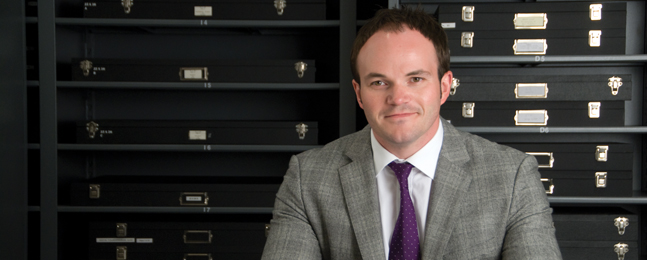New Director Promises to Cultivate Rose Art Museum’s Growth
Curator Christopher Bedford understands what’s new and what’s next.

Courtesy Still Moving Films
Christopher Bedford
Three years ago, Brandeis ignited a firestorm of criticism from alumni, faculty, students and the art world when the university announced plans to close the Rose Art Museum and sell art from its collection to help ameliorate a historic financial crisis. Although the university later agreed not to shutter the museum or sell artwork, many in the art world still regarded Brandeis with wariness. Now, Brandeis has signaled a new era for the Rose with the July appointment of a highly acclaimed director who promises to strengthen the university’s commitment to the visual arts.
Christopher Bedford, chief curator of exhibitions at Ohio State University’s Wexner Center for the Arts, will become the Henry and Lois Foster Director of the Rose Art Museum on Sept. 15. At 35, Bedford will be among the youngest museum directors in the United States when he takes the helm. He comes to Brandeis promising bold steps and a more thorough integration of the Rose into the life of the campus — a central goal set by the Future of the Rose Committee in its 2009 report.
A native of Scotland who grew up in England and the United States, Bedford has risen rapidly through the ranks at the J. Paul Getty Museum, the Los Angeles County Museum of Art and the Wexner, acquiring along the way a reputation as a visionary thinker about the engagement of art and the role of museums in society.
“Chris’ appointment demonstrates Brandeis’ commitment to strengthening the Rose as a center of innovation and excellence in the study and exhibition of the visual arts,” President Fred Lawrence said in announcing the appointment. “He understands the breadth of our ambition for a great museum as part of a great university.”
Prominent personalities of the contemporary art world, including Joel Wachs, president of the Andy Warhol Foundation for the Visual Arts, and artists Charline von Heyl and Mark Bradford, cited Bedford’s keen grasp of the contemporary art scene and his ability to get things done.
Bedford “is great,” Wachs says. “He is completely in touch with the contemporary art world, very smart and very energetic. He is a people person. He’s a scholar, he writes about art, he’s continually exploring new ideas. This is a great opportunity for him and a real test of Brandeis as well.”
German artist von Heyl, who is currently working on a show with Bedford, says, “I like the way that his eye works. He is one of those guys who have vision that is stubbornly true to their taste. That sounds like a no-brainer, but it is not so often that you meet that in the art world.”
page 2 of 2
“I am committed to the idea that art is integral to life, and university art museums are a perfect platform to demonstrate that commitment,” Bedford said in a recent telephone conversation from California, where he spent the first part of the summer at the Getty Leadership Institute for museum directors and curators. “It is essential that the community be drawn into the museum socially and intellectually, and that the collection be integrated into the curriculum of the university. This is not just a matter of service to the community — it will be an enrichment both of the community and of the museum. Ideally, it’s a mutually beneficial relationship.”
One of his top priorities, Bedford says, will be to commission a major work of public sculpture for the exterior of the museum that connects to ideas of social engagement and social justice: “Those concepts are central to my thinking and to the core ideology of Brandeis, too.” He says he feels it is essential to begin thinking about expanding the museum and making it a destination point for social activity both on campus and in the region.
While Bedford acknowledges that these plans will “take a lot of fundraising,” perhaps his most innovative and integrative idea will cost little or nothing. Bedford proposes “to take the conventional model of curating and turn it on its side if not its head.” Instead of having a single curator or director “drive” an exhibition, he says he will try “from the very beginning of an idea through its development into an exhibition to very determinedly engage minds from different disciplines across the university — art history, the life and environmental sciences — to work out thematic concerns that bind all the participants.”
Provost Steve A.N. Goldstein ’78, who appointed Bedford in consultation with members of a search committee of faculty, students, alumni and staff, says that “Chris Bedford understands the potential for art to impact society, the importance of art to help us understand the human experience, and the ability of art to change us.”
Both Bedford and Goldstein say that the new Rose director is arriving at a moment of golden opportunity for the museum. The way the art world and the campus rallied in opposition to selling art from the Rose when the university was in financial crisis created a broadened awareness and appreciation of the Rose collection and its importance to Brandeis, Bedford explains.
“I look forward to capitalizing on the legacy of that time, turning an unfortunate moment in the institution’s history into a positive moment of amplified visibility,” Bedford says.
Mark Bradford, a leading contemporary artist with whom Bedford has worked extensively, says, “For me, he has been the best of two worlds. He has the capacity to think professionally and maturely and get the job done, and at the same time he has the capacity to be flexible. He really, really believed in what I was doing. He really has integrity. He has a lot of faith in the artists he works with and the institutions he works for.”
